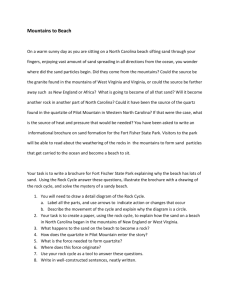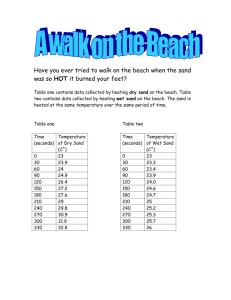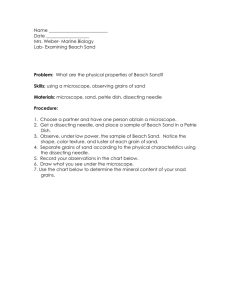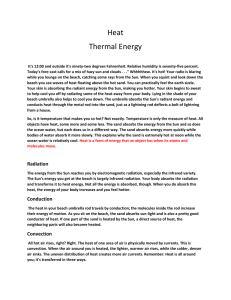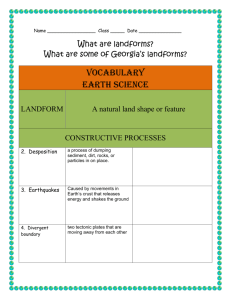Let`s Look at Sand
advertisement
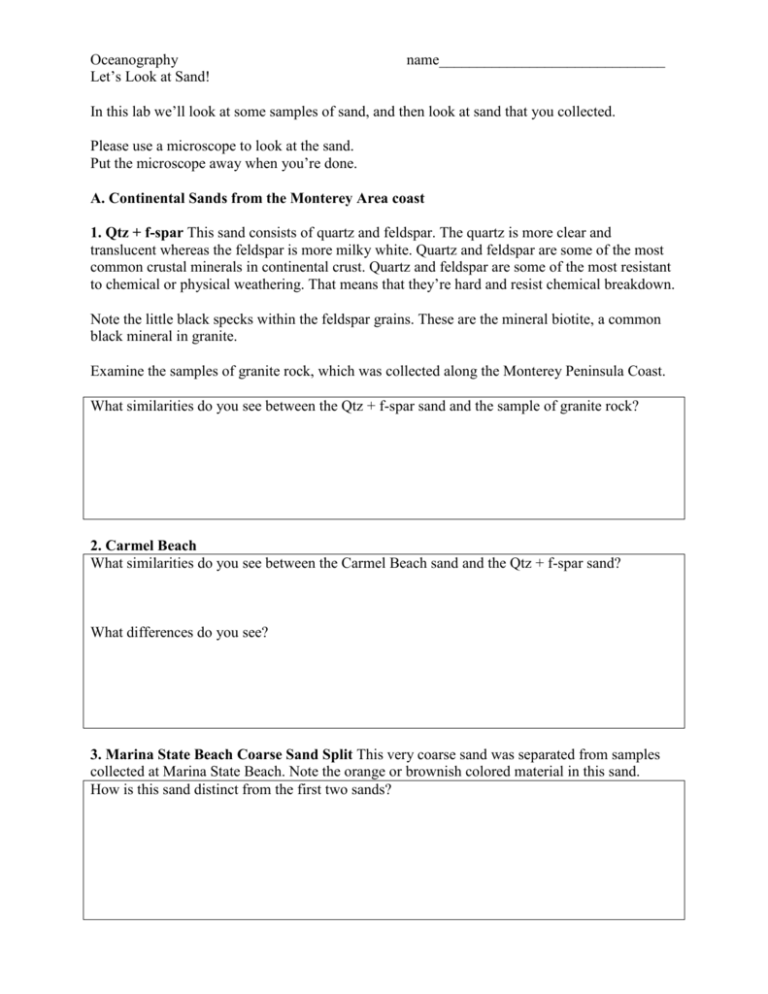
Oceanography Let’s Look at Sand! name______________________________ In this lab we’ll look at some samples of sand, and then look at sand that you collected. Please use a microscope to look at the sand. Put the microscope away when you’re done. A. Continental Sands from the Monterey Area coast 1. Qtz + f-spar This sand consists of quartz and feldspar. The quartz is more clear and translucent whereas the feldspar is more milky white. Quartz and feldspar are some of the most common crustal minerals in continental crust. Quartz and feldspar are some of the most resistant to chemical or physical weathering. That means that they’re hard and resist chemical breakdown. Note the little black specks within the feldspar grains. These are the mineral biotite, a common black mineral in granite. Examine the samples of granite rock, which was collected along the Monterey Peninsula Coast. What similarities do you see between the Qtz + f-spar sand and the sample of granite rock? 2. Carmel Beach What similarities do you see between the Carmel Beach sand and the Qtz + f-spar sand? What differences do you see? 3. Marina State Beach Coarse Sand Split This very coarse sand was separated from samples collected at Marina State Beach. Note the orange or brownish colored material in this sand. How is this sand distinct from the first two sands? B. Sands from Hawaii 1. Ke-awa-iki Beach Black Sand This sand comes from a beach where an 1859 Mauna Loa basalt lava flow reached the coast. Under the microscope, note the tiny vesicles (i.e., little holes) in many of the sand grains. This is a good way to identify basalt volcanic rock sand grains. This sample is important because basalt is the dominant rock type of the oceanic crust. It erupts prodigiously along mid-ocean ridges and at intra-plate hot-spot volcanoes like Hawaii. Note the rock samples of basalt. Note the little green minerals in the basalt. These are the mineral olivine. They formed while the basalt was still liquid magma, and are now preserved in the volcanic rock. Olivine forms almost exclusively in basalt, and is thus much more common in oceanic areas than in continental areas. 2. Green Sand Beach near South Point, HI This beach is near the southernmost point in the United States. It is unique because of the predominance of olivine, a mineral that occurs almost exclusively in basalt. And because it is very pretty. A very nice description of this Green Sand Beach is here: http://www.nvcc.edu/home/cbentley/geoblog/2008/12/green-sands-beach-hawaii.html What did you notice in the Monterey Area Beaches that is completely absent in these sands from Hawaii? 3. Ke-awa-iki Beach White Sand This sand is composed mostly of little fragments of coral and hard shell-like material from other marine organisms. It is composed of Calcium Carbonate (CaCO3). These types of organisms live mostly in warm shallow seas near the equator. Many white sands of tropical oceanic islands are composed of this type of material. What evidence do you see in these grains that show that they are composed of little bits of coral and other marine organisms? C. Summary Please summarize the differences between sands found in continental areas with those found on oceanic islands. D. Some Interesting Sands 1. Ft Cronkhite Beach This is the first real beach north of the Golden Gate in the Golden Gate National Recreation Area. The sand is absolutely beautiful. It consists of chert (the reds) and old metamorphosed basalt (the greens). The beach is near a stream that drains the Marin Headlands, which are composed mainly of these rock types. It is noteworthy for its lack of quartz and feldspar, especially for a continental sand. 2. Perfectly spherical foraminifera or coral sand. I’m not sure yet whether these sands are corals or foraminifera (a plankton with CaCO3 tests or hard parts). They are calcareous because they react with HCl. We don’t know which beach this sand comes from. 3. Garnet sand from the mouth of the Big Sur River at Andrew Molera State Park. We will visit this place on our field trip. The distinctive red mineral is garnet, which occurs in the metamorphic rocks of the Santa Lucia Range, the big mountain range of Big Sur. There are samples of the sand itself and of some garnet grains separated from the sand. 4. Carmel River Beach. Note the lack of sorting in this sand, as well as the angular nature of some of the sand grains. Could this be because these grains were recently delivered to the coast by the Carmel River? In terms of grain size, how does this sand differ from the Carmel Beach sand and the Marina State Beach sand? Out of all of these sands, which of these sands did you find most interesting, and why? E. Mystery Sample Examine the mystery sample and explain what type of place you think it comes from. Where does this sand come from, and why? F. Your sand Based on what you’ve read and done here in this lab, what are the noteworthy characteristics of the sand that you collected? Be sure to mention all of the following: Grain Size: Grain Composition: Degree of Sorting: What is the origin of this sand; how does it relate to its immediate surroundings?



